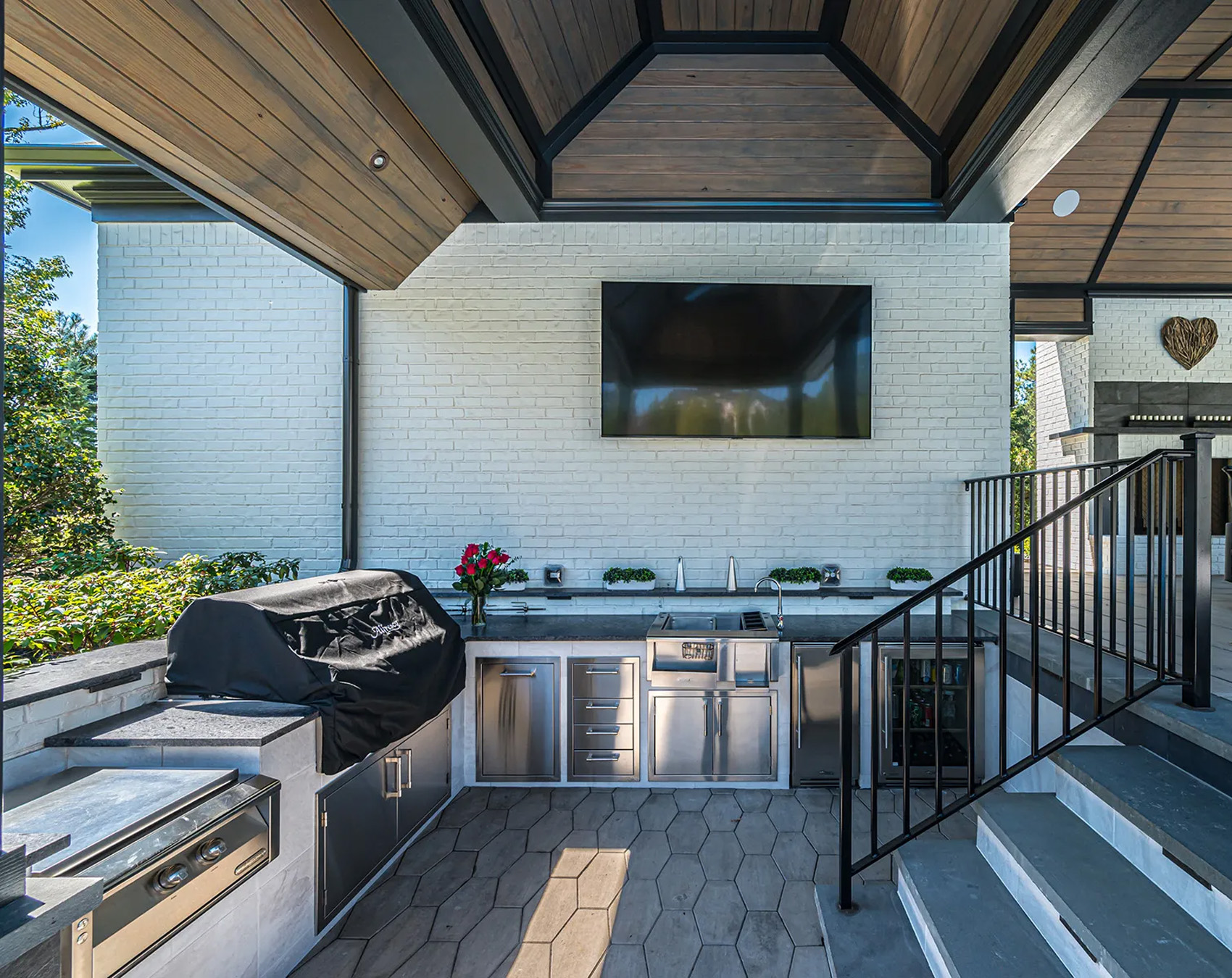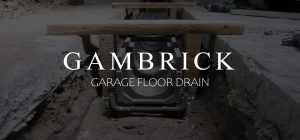How To Find Pipes In Brick Walls
The best way to find pipes in brick walls is with a detector. A stud finder, metal detector or thermal detector works best. You should also do a visual inspection and a tap test before drilling into the walls. Water lines, drains, vents and electrical wiring are essential parts of a well-built home. Water pipes distribute hot and cold water throughout the house while drain pipes and vent pipes expel water and gases from the home. These pipes all reside inside the walls behind the brick. In order to work on or update your plumbing, it’s important to find the exact location of the pipes. Locating pipes in a brick wall is harder than drywall because bricks are much denser. But there are a variety of methods, both invasive and non-invasive, which can help you find them.
Finding pipes in brick walls requires a certain level of expertise and experience. It’s a task that should be approached with caution, especially if you’re dealing with older buildings with complex and/or outdated plumbing systems. While some methods may seem simple and straightforward, it’s important to take the necessary safety precautions and seek professional help when needed.
In the following sections, I will provide a step-by-step guide on how to find pipes in brick walls using different techniques, including visual inspection, using a stud finder, conducting a tap test, and using a thermal camera. I will also explore alternative non-invasive methods such as pipe tracing and video camera inspection.
So, let’s get started and learn how to find pipes in brick walls like a pro.
Are Pipes Run Inside Brick Walls?
Yes, pipes are run inside solid brick walls and walls covered in brick veneer. To find them, do a visual inspection of the walls, attic, basement, crawl space, kitchen, laundry, bathrooms and even the roof to find vents. By looking at where water pipes exit the walls, you can figure out how they’re run throughout the home.
- Water pipes, drains and vents are run inside brick walls.
- In a single-story home, pipes usually only go up high enough to feed plumbing fixtures and not high up the walls.
- In multi-story homes, pipes are run from floor to ceiling.
- Most homes run plumbing from the ground up so you can find them inside the walls by inspecting the basement or crawl space.
When looking for pipes, inspect the basement, crawlspace, and attic before searching for pipes with other methods. A visual inspection will give you a general idea of how the pipes run throughout the home. You’ll also find out if they’re run high or low inside the walls.
- Pipes run from a basement will start at the bottom of the wall and come up to feed your sinks, toilets, and showers.
- Pipes in an attic will come down from the top of the wall to the fixtures.
- In single story homes, pipes rarely run from floor to ceiling.
- Two story homes or taller typically run piping from floor to ceiling.
Consider the size of your home when searching for pipes. Single-story homes typically run plumbing from the floor to the fixture height. However, multi-story homes will have pipes that run from floor to ceiling and in some cases, for multiple stories.
How To Find Pipes In Brick Walls
In order to find pipes inside a brick wall, start with a simple visual inspection. Examine the exterior of the wall for any signs of pipes, such as water or gas meters, pipe protrusions, or utility markings. On interior brick walls, look for visible pipes that may be exposed in the basement or crawl space. I typically start in the basement or in bathrooms and kitchens. Once you locate plumbing pipes, trace them around the house to see where they lead.
Once you’ve completed a visual inspection, move on to other methods like a stud finder, conducting a tap test and using a thermal camera.
Finding pipes in brick walls requires a combination of expertise, experience, and the right tools. Visual inspection, using a stud finder, conducting a tap test, and using a thermal camera are all effective methods that can help you locate any pipes inside a brick wall.
Stud Finder
After you map out the general locations of all the pipes you can see, use a stud finder to locate exact locations. A stud finder detects changes in density behind the wall, which can indicate the presence of pipes.
Start by calibrating the stud finder according to the manufacturer’s instructions. Then, slowly scan the wall in a horizontal direction, marking any locations where the stud finder indicates a change in density. Repeat this process in a vertical direction to create a grid-like pattern on the wall. The points where the horizontal and vertical lines intersect are the most likely locations for pipes.
Tap Test
Another method you can try is the tap test. Tap the brick lightly with a hammer or other hard object to listen for changes in sound. This can indicate the presence of pipes inside the wall.
Start by tapping the wall at regular intervals, listening for any changes in sound. A hollow sound may indicate an area without pipes, while a solid sound may indicate the presence of pipes. It’s important to tap gently to avoid damaging the wall or the pipes.
Thermal Camera
If all other methods fail, you can try using a thermal camera to detect changes in temperature behind the wall. This can indicate the presence of pipes. Turn on hot water to raise the temperature inside the wall. Then, point the thermal camera at the brick wall and look for temperature anomalies. Areas with higher temperatures may indicate the presence of pipes, as hot water or steam running through them can create heat.
Wall Scanner
A wall scanner is a more accurate way to find pipes in brick walls than a stud finder. They’re more sensitive and typically have a depth detector that can locate pipes deep inside the wall cavity. Use a wall scanner with a mode for “masonry.” This is very effective at scanning a brick wall because bricks are a form of masonry.
Follow the same basic steps used to find pipes with an electronic stud finder. This include:
- Turn on the hot and cold water to fill the pipes. This gives them more mass making them easier to detect.
- Run the wall finder horizontally along the wall very slowly and wait for it to detect a mass.
- Most water pipes are only 1/2 to 3/4 inch wide so scan slowly.
- In most cases a water pipe will run along side a stud. When you find a stud, slowly scan both sides for a pipe.
A wall scanner performs the same basic function as a stud finder. But they’re more expensive, more accurate, and better at detecting pipes inside a brick wall.
Check The Basement Or Crawl Space For Pipes
Most homes run plumbing throughout the house from the crawlspace or basement. If your crawl or basement is unfinished, it’s easy to follow the path of the plumbing up and into the walls. Once you see where the pipes turn upwards, you can trace them to the fixture they feed. Typically, pipes will go straight up through the floor to feed sinks, showers, laundry machines, and toilets.
- Inspect the ceiling of your basement or crawlspace to find out where plumbing lines run.
- Follow the path of the pipes up and through the walls to find out where they go.
- Shake the pipes in the basement and you can sometimes hear them in the walls above.
In most homes, plumbing is only run from the basement to the fixture the line feeds. On a one story home, there’s rarely plumbing above the fixture unless you have an HVAC unit in the attic.
In two story homes, there’s usually a main plumbing trunk running water from the basement to the 2nd floor. Two story homes may also run plumbing into the attic if there’s an HVAC unit.
Check The Attic For Pipes
Some homes have plumbing lines that run from the attic and run down the walls to the fixtures. If you don’t find plumbing lines in the crawl space or basement, inspect the attic.
If you find plumbing lines in your attic, follow them until the turn downwards into a wall. Then follow the path down the wall and to the fixture the plumbing supplies. In a one story home, plumbing will run to the fixture and stop. But in a two story home, there will be plumbing that runs from the attic to the lowest fixtures.
- If you don’t find plumbing lines in the basement or crawl space, search the attic.
- Follow the plumbing lines until the turn downward into a wall.
- Follow the path of the plumbing to the fixture they supply.
If your plumbing starts in the attic, the water lines will run from the top of the wall to the fixture.This can be more dangerous than plumbing that starts in the basement because the lines will be higher on the wall. Be extra careful when hanging pictures or drilling into the wall up high.
Before drilling holes or banging nails into the walls, make sure to locate all the plumbing lines to prevent leaks.
Pipe Detectors
The best way to find pipes inside a brick wall is with a non-invasive pipe detector. A detector can find pipes inside a wall by looking for heat or changes in density. They’re very effective, and when used with a visual and tap inspection, can locate pipes inside a solid brick wall.
- Stud Finder: A stud finder is the most basic type of detector that can locate a pipe. They’re very easy to use and most people that are into DIY work probably already have one. Stud finders work by detecting changes in density inside the wall. They can tell the difference between a void and a solid area. Normally they’re used to find wall studs, but they can also be used to locate hidden piping too.
- Metal Detectors: Metal detectors are specifically designed to locate metal. Some models are so sensitive, they can be used to not only locate a pipe, but also its depth inside the wall cavity. However, they don’t wok on non-metal pipes like PVC and PEX.
- Thermal Detectors: A thermal detector can see variations in heat. If you turn the hot water on, the detector will see where the pipes are located when they warm the wall. They can be even more effective when detecting pipes in a brick wall because bricks are very good at absorbing heat.
How To Detect Plastic Pipes In Brick Walls
Modern homes use less metal pipes in favor of things like PVC and PEX because it’s easier to work with a lot cheaper. However, plastic piping is harder to find in a brick wall because metal detectors won’t work on it and it’s harder to locate with a stud finder. One of the best way to find plastic pipes in a brick wall is with your ears. Plastic pipes sometimes move and make noise when the water turns on. It’s also easier to hear water rushing through them vs metal pipes.
In addition to listening for movement and water, there are a few other good ways to locate plastic pipes in a wall, these include:
- Video Camera Inspection: A small camera attached to a flexible cable can be used to inspect and locate pipes inside a wall.
- Thermal Camera: A thermal, a.k.a. heat, camera can see the hot water running through pipes inside a wall.
- Pipe Tracing: Pipe tracing involves using a specialized device to locate pipes behind walls. The device emits a signal that travels through the pipes, which can then be detected by a receiver. It’s a great way to find pipes but is only done by a professional.
- Visual Inspection: Inspect the walls and look for signs of plumbing. Check the attic and basement to map out how plumbing is run through the house. Inspect the roof, bathroom and kitchen for vents, drains and water lines.
Finding plastic pipes in a brick wall is harder than locating metal pipes. But with these techniques you’ll be able to locate the pipes without doing damage to the walls.
Why Locate Pipes Inside A Brick Wall?
One of the most common reasons to locate pipes in a brick wall is for plumbing or HVAC (heating, ventilation, and air conditioning) system maintenance or repair. For example, if you’re experiencing a leak in your plumbing system, finding pipes behind the wall can help you pinpoint the location of the leak and fix it more efficiently. Similarly, if you’re installing a new HVAC system, finding pipes inside the wall can help you plan your installation more efficiently.
Another reason why you might need to find pipes inside brick walls is for home improvement or renovation projects. For example, if you plan on installing a new bathroom or kitchen, finding the pipes will help you plan the layout and ensure that the plumbing system is properly installed.
If you are a professional or a DIY plumber that’s planning to drill holes in the walls, you must locate the plumbing first to avoid damage to the existing pipes and wire network.
- If you suspect a leak inside the wall, you’ll have to find the pipes before you can fix it.
- If you’re doing a renovation project involving plumbing, you’ll need to find existing piping to tap into.
Locating any pipes inside the walls helps ensure your existing and new plumbing, vents, drains and HVAC systems function properly.
Tips On How To Detect Pipes Inside A Brick Wall
Finding pipes inside a brick wall is easy if you have the right tools and know-how. I’ve worked in construction for over 25 years on older homes and once you learn how, finding hidden pipes in brick becomes very routine.
Here is a step by step guide on how to find pipes inside a brick wall:
- Turn off your appliances: Start by turning off all the appliances that use water.
- Turn off the water supply: If you accidentally hit a water pipe, its best to have the water shut off to reduce leaks.
- Look out for light switches and electrical sockets: Before using an invasive method to find pipes, inspect the area for electrical wiring inside the wall. Look at the wall itself, in the basement and attic to find wires that may be running inside and through the wall.
- Look for radiators: If the home has hot water radiators, the pipes are a separate plumbing system then regular water pipes. To find radiator pipes inside a brick wall, turn the heat up and feel the wall. The areas of brick directly in front of heat pipes will warm up.
- Be careful with bathroom and kitchen brick walls: Bathroom and kitchen brick walls can be harder to detect specific water pipes because they tend to have more plumbing, drain and vent pipes running inside them.
- Use a detector: Drilling into a brick wall to find pipes can be risky. To avoid leaks, it’s best to use a non-invasive detector. A pipe detector can locate pipes within a brick wall with a high degree of accuracy.
After a visual inspection is completed, use detectors or a tap test to detect pipes inside a brick wall. Drilling holes is risky and should be considered a last ditch effort.
Non-Invasive Professional Ways To Find Pipes In Brick
Non-invasive techniques are the best way to find pipes in a brick wall. They can be done without drilling holes or doing any demolition work. Invasive methods can be risky, especially if you’re dealing with older buildings or complex plumbing systems. In such cases, non-invasive techniques are a safer and more efficient way of finding the pipes.
There are several very effective non-invasive methods that plumbers can do to locate pipes in a brick wall:
- Pipe Tracing: Pipe tracing involves using a specialized device to locate pipes behind walls. The device emits a signal that travels through the pipes, which can then be detected by a receiver. This allows you to trace the exact location of the pipes without making holes or cuts in the wall. Pipe tracing is particularly useful when dealing with older buildings or when trying to locate pipes that are buried deep within the wall.
- Video Camera Inspection: A small camera attached to a flexible cable can be used to inspect the inside of the pipes. The camera captures real-time footage, which can then be viewed on a monitor, allowing you to see the location and condition of the pipes without having to cut into the wall. Video camera inspection is particularly useful for diagnosing issues with pipes, such as leaks or blockages.
Non-invasive techniques such as pipe tracing and video camera inspection can be a safer and more efficient way of finding pipes in brick walls, particularly when dealing with older buildings or complex plumbing systems. But they require specialized equipment and trained professional.
If you’re interested in having either method done at your home, contact a plumber that has the necessary equipment.
What Can Happens If You Drill Into A Wall Without Checking?
Drilling into a wall without checking for pipes or other utilities can have serious consequences like water leaks. If water continues to leak inside a wall, it could eventually cause rot, mildew, mold, deterioration and structural damage. The best way to find hidden leaks is to look for dark spots, damp areas of brick or an increase in your water bill. You can also inspect the basement below walls to look for signs of water.
Here are some of the potential risks:
- Damage to pipes: If you drill into a wall without checking for pipes, you run the risk of damaging the pipes. This can cause leaks or other problems, which can be costly to repair.
- Electrical shock: Drilling into a wall without checking for electrical wires can result in electrical shock, which can be dangerous or even deadly. If you accidentally drill into an electrical wire, it can cause a short circuit, which can cause a fire or damage to your electrical system.
- Structural damage: Drilling into a wall without checking for structural elements such as beams or studs can weaken the structure of your home, which can cause walls or ceilings to collapse.
- Inconvenience: Drilling into a wall without checking for pipes or other utilities can result in having to turn off the water or electricity, which can be inconvenient and disrupt your daily routine.
It’s important to take the time to check for pipes or other utilities before drilling into a wall to avoid any potential risks or damage.
Can A Stud Finder Locate Water Pipes In A Brick Wall?
Yes, a stud finder can be used to locate pipes inside a brick wall. They’re designed to detect a solid mass inside a wall cavity which includes water pipes, drains and vent. But because water pipes are much smaller than a wall stud, they’re harder to detect.When looking for pipes with a stud finder, use one with a high sensitivity rating and the ability to detect depth.
- Use a high-quality electronic stud finder with deep scanning mode and metal detection to find water pipes in your walls.
- A simple laser stud finder or a magnetic stud finder isn’t the best choice.
- Use a stud finder with a screen to help determine what the stud finder has detected.
- Turning on both the cold and hot water can help your stud finder detect the pipes.
Pipes are usually located deeper inside the wall cavity than a stud. This makes them harder to detect without a highly sensitive detector. I recommend using a detector that can also detect depth. It will help you locate the pipes and differentiate between pipes and studs.
Most stud finders won’t detect plastic pipes unless there’s water running through them. This is because plastic pipes aren’t as solid as metal pipes. To compensate for this, turn on the hot and cold water. When water rushes through the pipes it becomes easier for the detector to find them.
Summary: How To Find Pipes In Brick Walls
The best way to find pipes in brick walls is with a detector. A stud finder, metal detector or thermal detector works best. You should also do a visual inspection and a tap test before drilling into the walls. Water lines, drains, vents and electrical wiring are essential parts of a well-built home. Water pipes distribute hot and cold water throughout the house. Drain pipes and vent pipes expel water and gases from the home. These pipes all reside inside the walls behind the brick. In order to work on or update your plumbing, it’s important to find the exact location of the pipes. Locating pipes in a brick wall is harder than drywall because bricks are much denser. But there are a variety of methods, both invasive and non-invasive, which can help you find them.
Finding pipes in brick walls requires a certain level of expertise and experience. It’s a task that should be approached with caution. Especially if you’re dealing with older buildings with complex and/or outdated plumbing systems. While some methods may seem simple, it’s important to take the necessary safety precautions. And seek professional help when needed.
If you have any questions or comments about how to find pipes in brick walls, email any time.
























